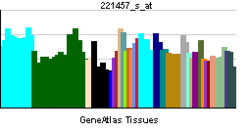BTNL2
| BTNL2
|
|---|
|
| Identifiers |
|---|
| Aliases |
BTNL2, BTL-II, BTN7, HSBLMHC1, SS2, butyrophilin like 2 |
|---|
| External IDs |
MGI: 1859549 HomoloGene: 10482 GeneCards: BTNL2
|
|---|
|
| Genetically Related Diseases |
|---|
| multiple sclerosis, hepatitis C, liver cirrhosis, , lung adenocarcinoma, ulcerative colitis[1] |
| RNA expression pattern |
|---|
 |
| More reference expression data
|
| Orthologs |
|---|
| Species |
Human |
Mouse |
|---|
| Entrez |
|
|
|---|
| Ensembl |
|
|
|---|
| UniProt |
|
|
|---|
| RefSeq (mRNA) |
| |
|---|
| RefSeq (protein) |
| |
|---|
| Location (UCSC) |
Chr 6: 32.39 – 32.41 Mb |
Chr 17: 34.35 – 34.37 Mb |
|---|
| PubMed search |
[2] |
[3]
|
|---|
| Wikidata |
Butyrophilin-like protein 2 is a protein that in humans is encoded by the BTNL2 gene.[4][5][6]
References
- ↑ "Diseases that are genetically associated with BTNL2 view/edit references on wikidata".
- ↑ "Human PubMed Reference:".
- ↑ "Mouse PubMed Reference:".
- ↑ Stammers M, Rowen L, Rhodes D, Trowsdale J, Beck S (May 2000). "BTL-II: a polymorphic locus with homology to the butyrophilin gene family, located at the border of the major histocompatibility complex class II and class III regions in human and mouse". Immunogenetics. 51 (4–5): 373–82. doi:10.1007/s002510050633. PMID 10803852.
- ↑ Valentonyte R, Hampe J, Huse K, Rosenstiel P, Albrecht M, Stenzel A, Nagy M, Gaede KI, Franke A, Haesler R, Koch A, Lengauer T, Seegert D, Reiling N, Ehlers S, Schwinger E, Platzer M, Krawczak M, Muller-Quernheim J, Schurmann M, Schreiber S (Mar 2005). "Sarcoidosis is associated with a truncating splice site mutation in BTNL2". Nat Genet. 37 (4): 357–64. doi:10.1038/ng1519. PMID 15735647.
- ↑ "Entrez Gene: BTNL2 butyrophilin-like 2 (MHC class II associated)".
Further reading
- Strausberg RL, Feingold EA, Grouse LH, et al. (2003). "Generation and initial analysis of more than 15,000 full-length human and mouse cDNA sequences". Proc. Natl. Acad. Sci. U.S.A. 99 (26): 16899–903. doi:10.1073/pnas.242603899. PMC 139241
 . PMID 12477932.
. PMID 12477932.
- Mungall AJ, Palmer SA, Sims SK, et al. (2003). "The DNA sequence and analysis of human chromosome 6". Nature. 425 (6960): 805–11. doi:10.1038/nature02055. PMID 14574404.
- Hiller M, Huse K, Szafranski K, et al. (2005). "Widespread occurrence of alternative splicing at NAGNAG acceptors contributes to proteome plasticity". Nat. Genet. 36 (12): 1255–7. doi:10.1038/ng1469. PMID 15516930.
- Rybicki BA, Walewski JL, Maliarik MJ, et al. (2006). "The BTNL2 gene and sarcoidosis susceptibility in African Americans and Whites". Am. J. Hum. Genet. 77 (3): 491–9. doi:10.1086/444435. PMC 1226214
 . PMID 16080124.
. PMID 16080124.
- Traherne JA, Barcellos LF, Sawcer SJ, et al. (2006). "Association of the truncating splice site mutation in BTNL2 with multiple sclerosis is secondary to HLA-DRB1*15". Hum. Mol. Genet. 15 (1): 155–61. doi:10.1093/hmg/ddi436. PMID 16321988.
- Orozco G, Eerligh P, Sánchez E, et al. (2006). "Analysis of a functional BTNL2 polymorphism in type 1 diabetes, rheumatoid arthritis, and systemic lupus erythematosus". Hum. Immunol. 66 (12): 1235–41. doi:10.1016/j.humimm.2006.02.003. PMID 16690410.
- Campo I, Morbini P, Zorzetto M, et al. (2007). "Expression of receptor for advanced glycation end products in sarcoid granulomas". Am. J. Respir. Crit. Care Med. 175 (5): 498–506. doi:10.1164/rccm.200601-136OC. PMID 17170388.
- Arnett HA, Escobar SS, Gonzalez-Suarez E, et al. (2007). "BTNL2, a butyrophilin/B7-like molecule, is a negative costimulatory molecule modulated in intestinal inflammation". J. Immunol. 178 (3): 1523–33. doi:10.4049/jimmunol.178.3.1523. PMID 17237401.
- Möller M, Kwiatkowski R, Nebel A, et al. (2007). "Allelic variation in BTNL2 and susceptibility to tuberculosis in a South African population". Microbes Infect. 9 (4): 522–8. doi:10.1016/j.micinf.2007.01.011. PMID 17347014.
- Johnson CM, Traherne JA, Jamieson SE, et al. (2007). "Analysis of the BTNL2 truncating splice site mutation in tuberculosis, leprosy and Crohn's disease". Tissue Antigens. 69 (3): 236–41. doi:10.1111/j.1399-0039.2006.00795.x. PMID 17493147.
- Mochida A, Kinouchi Y, Negoro K, et al. (2007). "Butyrophilin-like 2 gene is associated with ulcerative colitis in the Japanese under strong linkage disequilibrium with HLA-DRB1*1502". Tissue Antigens. 70 (2): 128–35. doi:10.1111/j.1399-0039.2007.00866.x. PMID 17610417.
- Spagnolo P, Sato H, Grutters JC, et al. (2007). "Analysis of BTNL2 genetic polymorphisms in British and Dutch patients with sarcoidosis". Tissue Antigens. 70 (3): 219–27. doi:10.1111/j.1399-0039.2007.00879.x. PMID 17661910.

 . PMID 12477932.
. PMID 12477932. . PMID 16080124.
. PMID 16080124.